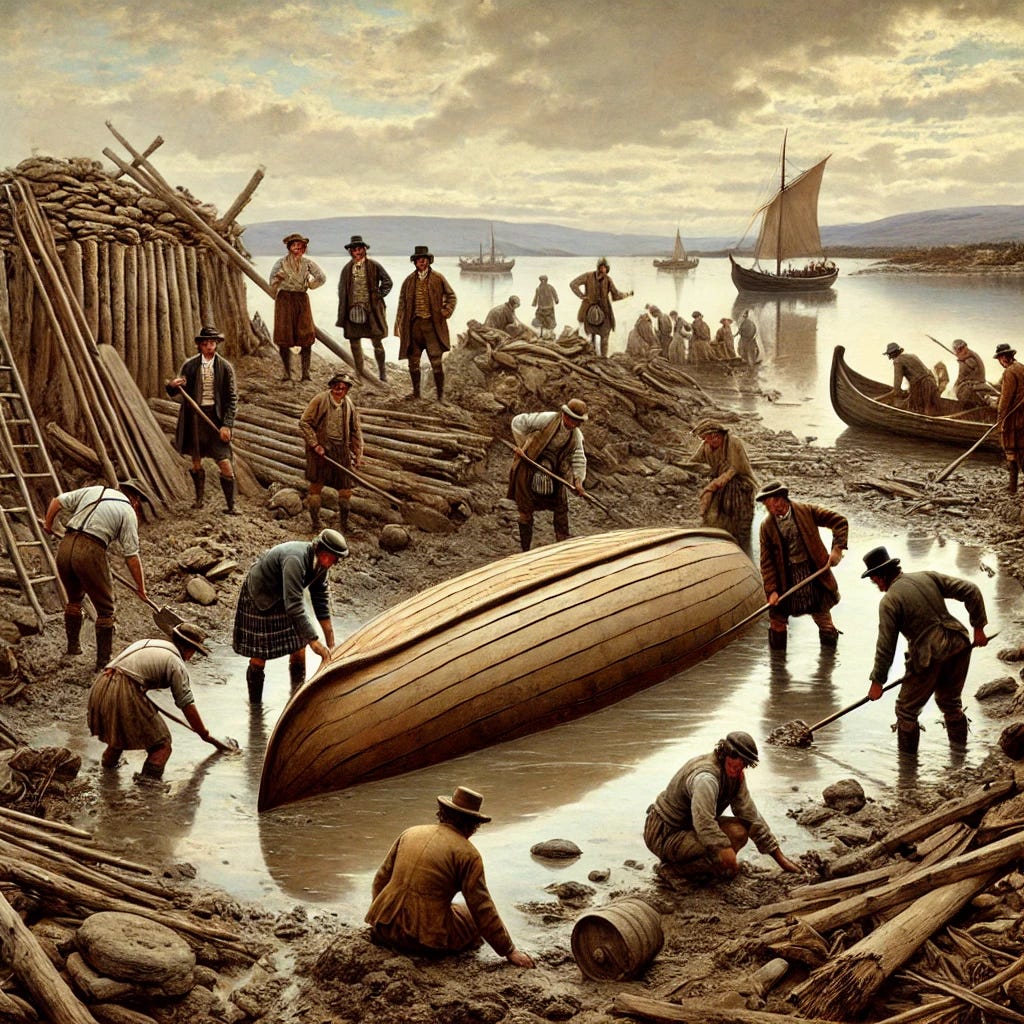The Cannibal Canoes of Loch Kinnord
Loch Kinnord, a serene body of water nestled in the Highlands of Scotland, holds within its depths secrets of an ancient past. Among the most intriguing discoveries are the so-called “cannibal canoes”—a term coined to describe the enigmatic vessels unearthed during the draining of the loch in the 19th century. These relics, which seem to have swallowed their own stories, raise questions about their purpose, their origin, and the lives they once served.
Unearthing the Canoes
The first major discovery of these canoes occurred in 1859 during efforts to lower the loch's water level to supply the mill at Dinnet. Among the recovered artifacts was a logboat, later referred to as Loch Kinord 1, or the "Royal Yacht." This vessel, measuring over 22 feet long and 3 feet wide, displayed evidence of extensive use, including multiple repairs. Its carefully squared stern and pointed bow reflect the craftsmanship of early inhabitants, while the thickness-gauge holes along its structure hint at its practical maritime use.
Later, in 1875, two more canoes, known as Loch Kinord 2 and 3, were recorded near the same site but unfortunately did not survive the passage of time. Around this period, a fourth logboat, Loch Kinord 4, was discovered near the crannog known as Prison Island. This vessel, found filled with stones, was likely deliberately sunk. When recovered in 1962, it measured 12 feet long and 2.5 feet wide, with a worn hole near its stern, suggesting it may have been anchored or secured in some way.
Theories of Ritualistic Sacrifice
The idea of "cannibal canoes" stems from the suggestion that these vessels might have played a role in sacrificial ceremonies, symbolic of consuming or offering their cargo to the loch. The deliberate sinking of Loch Kinord 4, filled with stones, strengthens the theory of ritualistic intent. Scotland’s history of water worship offers further context. Bodies of water were often seen as thresholds between the mortal and divine realms. The deliberate placement of artifacts, and in some cases human remains, into lochs aligns with the belief that such offerings ensured prosperity, protection, or divine favor.
Could these canoes have ferried offerings to crannogs before being ceremonially sunk? The proximity of these vessels to Prison Island, a known crannog, strengthens this hypothesis. Additionally, the timber construction and design of these canoes reflect a society that deeply valued both functionality and symbolism.
Practical Uses and Historical Context
While ritualistic theories are compelling, the canoes’ craftsmanship also points to practical uses. Loch Kinord 1, with its carefully constructed stern and bow, was clearly built for regular use. It was discovered with evidence of attempted repairs, indicating it had been relied upon for transport or trade for an extended period.
However, the region’s history of clan conflicts complicates the narrative. The Gordons, who dominated the area, were deeply involved in Scottish civil wars and local skirmishes. The sinking of some canoes could have been a defensive act, perhaps to deny their use to enemy forces.
Artifacts Beyond the Canoes
The significance of Loch Kinnord extends beyond its canoes. The loch has yielded a treasure trove of historical artifacts, suggesting its importance as both a practical and ceremonial site. Among the most notable discoveries are:
A medieval bronze jug, acquired by the National Museum of Antiquities of Scotland in 1900.
A small bronze cup, presented to the same museum in 1912.
A 13th to 16th-century iron axe, now housed in the Inverurie Museum, believed to have been used by woodworkers or carpenters in the region.
These artifacts, alongside the canoes, paint a vivid picture of life around Loch Kinnord—a blend of daily utility, artistry, and spiritual significance.
Modern Interpretations
Advances in underwater archaeology and dendrochronology have allowed researchers to better understand the timeline of these canoes and other artifacts. Loch Kinord 1, for instance, has been dated to the early medieval period, aligning with the rise of crannog construction. Its discovery, alongside other vessels, highlights the ingenuity of early Highland communities and their intricate relationship with the loch.
Legends in the Making
While we may never fully uncover the truth behind the cannibal canoes, their legacy endures. They symbolize a time when life and death, ritual and practicality, were intimately intertwined. As the loch waters lap against the shore, they seem to whisper stories of those who once paddled, prayed, and perhaps perished in their embrace.
Loch Kinnord, with its sunken secrets and storied past, continues to intrigue those who seek to connect with Scotland’s layered history. The cannibal canoes stand as silent witnesses, their submerged tales waiting for the right moment—or the right discovery—to rise again.





